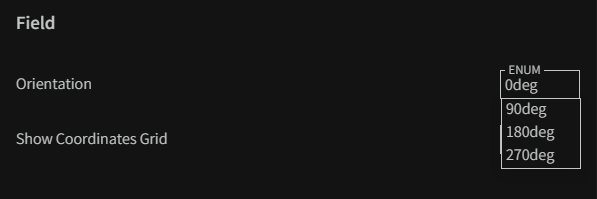Field View
It provides a dynamic and interactive visualization of the game field, allowing teams to monitor their robot's position, orientation, and interactions with game elements in real-time. This feature is particularly useful for debugging autonomous flows, tracking robot movements.
It works live a canvas, so it can be used for any drawing application.
Supported Objects
- Line
- Circle
- Rectangle
More will be added soon
Customization
You can change the orientation and show a coordinates grid inside the settings menu.
There are also methods on the Canvas object to change the orientation programatically: setOffsets.

Gotchas
- Objects are drawn in the order they are sent to the
debugfunction, and their layering (z-index) is automatically managed by the system. - The input order is flexible, you can provide Drawable objects and text lines in any order within the debug function.
- Every Drawable object requires a
lookto define its visual appearance. The look specifies styling attributes such as fillColor, outlineColor, outlineWidth.
Offsets
You can offset the canvas coordinate system using either custom parameters or predefined presets. This action can be performed on both the Canvas and the Telemetry instance exposed by Panels.
Included Presets
PANELS: DefaultROADRUNNERPEDRO_PATHING
You can also define custom presets by implementing the CanvasPreset interface.
Example
val PEDRO_PATHING = CanvasPreset {
it.offsetX = -24.0 * 3
it.offsetY = 24.0 * 3
it.rotation = CanvasRotation.DEG_270
}Example OpMode File: TestOpMode.kt
Below is an example of how field telemetry can be implemented in an OpMode:
package org.firstinspires.ftc.teamcode.examples.field
import com.bylazar.ftcontrol.panels.Panels
import com.bylazar.ftcontrol.panels.json.CanvasRotation
import com.bylazar.ftcontrol.panels.json.Circle
import com.bylazar.ftcontrol.panels.json.Line
import com.bylazar.ftcontrol.panels.json.Look
import com.bylazar.ftcontrol.panels.json.Point
import com.bylazar.ftcontrol.panels.json.Rectangle
import com.qualcomm.robotcore.eventloop.opmode.OpMode
import com.qualcomm.robotcore.eventloop.opmode.TeleOp
import kotlin.random.Random
@TeleOp(name = "Field Test OpMode")
class TestOpMode : OpMode() {
var panelsTelemetry = Panels.getTelemetry()
override fun init() {
panelsTelemetry.setOffsets(24.0, 24.0, CanvasRotation.DEG_0) //field offsets in inches
panelsTelemetry.debug("Init was ran!")
panelsTelemetry.update(telemetry)
}
override fun loop() {
panelsTelemetry.debug("Loop ${System.currentTimeMillis()} ran!")
panelsTelemetry.debug(
Line(
Point(0.0, 0.0),
Point(0.0, Random.nextDouble(0.0, 10.0)),
).withLook(
Look(
outlineColor = "red",
outlineWidth = 1.0,
fillColor = "",
opacity = 1.0
)
),
Circle(
Point(20.0, 20.0),
Random.nextDouble(0.0, 10.0),
).withLook(
Look(
outlineColor = "blue",
outlineWidth = 1.0,
fillColor = "yellow",
opacity = 1.0
)
),
Rectangle(
Point(40.0, 40.0),
Random.nextDouble(0.0, 10.0),
Random.nextDouble(0.0, 10.0),
).withLook(
Look(
outlineColor = "green",
outlineWidth = 1.0,
fillColor = "",
opacity = 1.0
)
)
)
panelsTelemetry.update(telemetry)
}
}Example Drawer File: Drawer.kt
Below is an example of how field telemetry can be implemented in an utility without the opMode loop:
package org.firstinspires.ftc.teamcode.examples.field
import com.bylazar.ftcontrol.panels.Panels
import com.bylazar.ftcontrol.panels.json.Canvas
import com.bylazar.ftcontrol.panels.json.CanvasRotation
import com.bylazar.ftcontrol.panels.json.Circle
import com.bylazar.ftcontrol.panels.json.Look
import com.bylazar.ftcontrol.panels.json.Point
class Drawer {
fun draw() {
val canvas = Canvas().withOffsetX(0.0).withOffsetY(0.0).withRotation(CanvasRotation.DEG_0)
canvas.add(
Circle(
center = Point(0.0, 0.0),
radius = 10.0,
).withLook(
Look(
outlineColor = "red",
outlineWidth = 1.0,
fillColor = "",
opacity = 1.0
)
)
)
Panels.getTelemetry().sendCanvas(canvas)
}
}A library by Lazar from 19234 ByteForce.